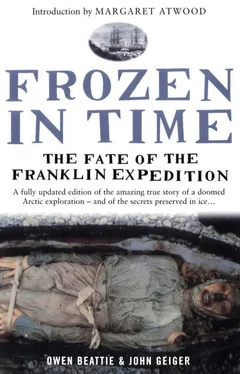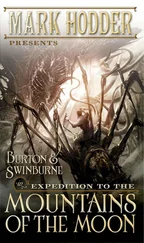What is very clear from the findings, however, now based on more than four (including the Booth Point skeleton and other bones gathered on King William Island in 1982) separate individuals and using the facilities of a series of different labs, is that lead played an important role in the declining health of the entire crews of the Erebus and Terror —not only in their loss of physical energy but increasingly in their minds’ despair. Loss of appetite, fatigue, weakness and colic are some of the physical symptoms of lead poisoning; it can also cause disturbances of the central and peripheral nervous systems, producing neurotic and erratic behaviour and paralysis of the limbs. But it is the effects on the mind that may have been of greatest importance in isolating the impact of lead on the expedition. Under the continuing and prolonged stressful conditions of long periods in the Arctic, even very subtle effects of low lead exposure could have had significant impact on the decisionmaking abilities of the men, particularly the officers. Only clear minds can hope to make correct decisions.
There is no single reason why the expedition failed, of course; it was a deadly combination of factors. That is why there is no one answer to the question of what caused the Franklin expedition disaster. Perhaps the best that can be done today is to isolate the reasonable possibilities and fit them into the broad circumstances as identified from the scattered remains found at archaeological sites. This is what Beattie was able to do.
In some cases, such as the three sailors from Beechey Island, the effects of lead poisoning were catastrophic. Amy’s autopsy results showed that, like Torrington, both Hartnell and Braine suffered from tuberculosis and died of pneumonia. In addition, radiological evidence obtained by Derek Notman identified a collapsed eleventh thoracic vertebra in William Braine, a condition caused by Pott’s disease, which in turn is usually caused by tubercular infection. But it was the insidious and poorly understood poison, lead, entering their bodies at high levels over the course of the first months of the expedition, that weakened these three young men to the point that they were easily killed off by supervening diseases. Other crewmen would have been as severely affected by the poisoning, which probably explains at least some of the other twenty-one deaths experienced by the expedition in the early period before the ships were deserted on 22 April 1848.
As for the high ratio of officer deaths prior to the death march (nine out of twenty-one), Beattie found possible explanations consistent with the lead findings. If the officers, a rigidly separated and very aloof class, even during long and confined expeditions, were using their pewter tableware and eating a preferential food source (that is, proportionately more tinned food), they may have ingested much higher levels of lead than the other seamen. It is at least possible that Sir John Franklin himself died directly or indirectly from the effects of lead poisoning.
As for those men who died during the tragic death march in the spring and summer of 1848, some may have exhibited classic symptoms of the poisoning, such as anorexia, weakness and fatigue and paranoia, which would have compounded the effects of starvation and scurvy. Other crewmen may not have shown any obvious effects of the poison, perhaps because of differing diets and physical responses to the lead.
It is sadly ironic that Franklin’s expedition, certainly one of the greatest seafaring expeditions ever launched, carrying all the tools that early industry and innovation could offer, should have been mortally wounded by one of them. Yet Beattie now believed he had the scientific evidence to say that this was the case.
When Sir John Franklin sailed from the Thames in May 1845, an entire nation believed that the honour of conquering the Northwest Passage was within his grasp. None could have known that inside the tins stored in the ship’s hold there ticked a time bomb that helped not only to deny Franklin his triumph but to steal away 129 brave lives. And while good hopes decayed in a relatively short time for the expedition crews, the physicians aboard the Erebus and Terror would have been helpless to intervene. The health risks imposed by the use of lead-tin solder were simply not appreciated at that time. (It was not until 1890 that government legislation in Britain finally banned soldering on the insides of food tins.)
THERE IS OFTEN a terrible price to pay in human exploration reliant upon new technology. That fact was vividly demonstrated again in recent years by the failure of the space shuttles Challenger in 1986 and Columbia in 2003. Indeed, our explorers of space share a bond with past explorers of the unknown frozen shores of the earth. In many ways, there is no difference between the Franklin and space shuttle disasters. Time, technology, social conditions and politics have changed, but the spirit and motivation underlying both endeavours remain. Both used the most advanced technology of their time and both paid the ultimate price. An article published in an 1855 edition of Blackwoods Edinburgh Magazine laments those dangers:
We confess we have not heart enough, in the general enterprise of knowledge, to view such a sacrifice as that of Franklin and his crew without a chill of horror: there is something frightful, inexorable, inhuman, in prosecuting researches, which are mere researches, after such a costly fashion… and when we hear of the martyrs of science, whether they perish among the arctic snow or the sands of the desert, we begin to think of science herself as a placid Juggernaut… with benevolent pretensions, winning, by some weird magic, and throwing away with all the calmness of an abstract and impersonal principle, those generous lives.
These thoughts, published even before M’Clintock made his grisly discoveries, could have been written in response to Beattie’s. But such conclusions dwell only on the failure of science and technology and deny the achievements. For after Franklin, others followed. They too used the latest technology available to them, and they succeeded not only in tracing a Northwest Passage but in conquering the last and most forbidding land on earth.
For decades, the elaborate historical constructs fashioned by students of the Franklin disaster provided a grimly satisfactory explanation of the tragedy, one that neatly adhered to prevailing expectations. Fundamentally, the expedition was viewed as a momentous test of endurance against the malignant forces of nature; Franklin’s defeat, alas, confirmed the hideous risks that that entailed. Subsequent investigations rarely strayed from the well-worn path—reliance on the cumulative wisdom of early searchers, written records and accepted truths—to consider physical clues, such as first-hand observation and analysis of food sources. Even then, the work was encumbered by the limitations of the existing technology for scientific analysis.
When a Franklin expedition tin, retrieved by M’Clintock, was opened and examined in 1926, the beef contents were declared to be “perfectly satisfactory.” In light of the catastrophic health consequences of ingesting the lead-contaminated contents of such tins, they would seem to have proven rather less than satisfactory to those reliant on the tainted provisions. Results from the contemporary analyses of the human soft-tissue samples by Walt Kowal, Owen Beattie and their colleagues, published in 1991 in the Journal of Archaeological Science, only served to underscore the dramatic nature of the lead poisoning identified in the bodies of Beechey Island. Comparison with lead levels in modern populations, even in instances of occupational exposure, confirmed the devastating effects. Lead levels in the soft tissues of the crew members averaged ten to thirty times higher than in modern unexposed individuals. The pattern was similar in all soft tissues examined, including the aorta, stomach, kidney, liver, lung, spleen, bladder, muscle and intestine.
Читать дальше










